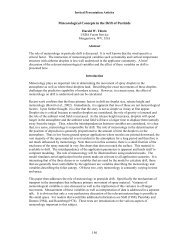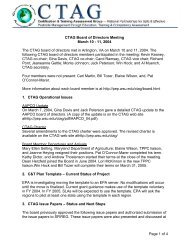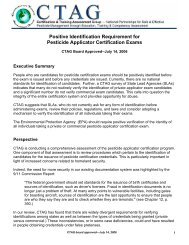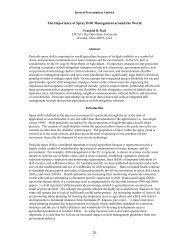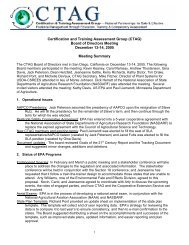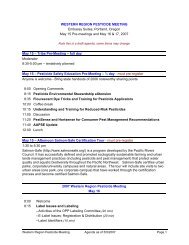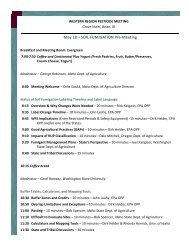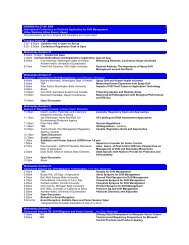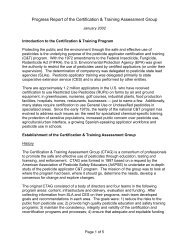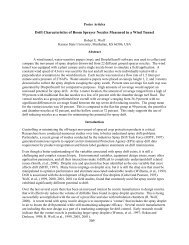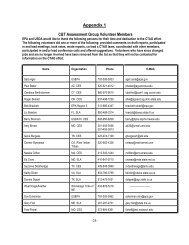Challenges and Successes of the EPA's Pesticide Environmental ...
Challenges and Successes of the EPA's Pesticide Environmental ...
Challenges and Successes of the EPA's Pesticide Environmental ...
- No tags were found...
Create successful ePaper yourself
Turn your PDF publications into a flip-book with our unique Google optimized e-Paper software.
Partnership Programs at EPA OPP• <strong>Environmental</strong> Stewardship Branch:• <strong>Pesticide</strong> <strong>Environmental</strong> StewardshipProgram (PESP)• IR-4 Bio-demonstration Project• Lawn & <strong>the</strong> Environment• Golf & <strong>the</strong> Environment• Strategic Ag. Initiative
Partnership Programs Gaining Momentum• Partnership programs are taking on increasedimportance at <strong>the</strong> EPA• The value <strong>of</strong> innovative approaches toenvironmental issues is becoming more clear• The EPA is using partnership programs as acomplimentary tool to regulatory activities• However, with this new visibility comes newscrutiny• Measuring <strong>the</strong> success <strong>of</strong> <strong>the</strong>se partnershipprograms is critical in <strong>the</strong> coming years
Measuring our Success <strong>of</strong> PartnershipPrograms• Taking on a renewed focus within <strong>the</strong> EPA• Following a larger trend in business,government, <strong>and</strong> charity – a stronger focus onaccountability• Within EPA, partnership programs are beingevaluated – defining programs, evaluatingefficiency <strong>and</strong> impact, working towards someglobal recommendations
How does this Impact our Partners in <strong>the</strong><strong>Pesticide</strong> User Community ?• Measuring impacts <strong>of</strong> PESP projects becomescritical• Picking successful collaborations – partners,expected outcome, scale up potential, impact• Agriculture (diverse commodities)• Non-agriculture (schools, residences,commercial buildings, golf courses <strong>and</strong> more)• Energy Star – PESP communications challenges
Emerging Topics for PESP• Concept, partners, how can we measure <strong>the</strong>success• Power <strong>of</strong> food processors <strong>and</strong> certificationprograms• Community IPM – where we live, work, learn, <strong>and</strong>play• Communication potential from <strong>the</strong> scale up fromproject level to larger success – ADOPTION• Invest resources to demonstrate an innovativetechnique – <strong>the</strong> broader adoption is a truemeasure <strong>of</strong> <strong>the</strong> success
Future Challenge – Technology Transfer• EPA <strong>and</strong> partners <strong>of</strong>ten work toge<strong>the</strong>r to ei<strong>the</strong>rresearch or demonstrate new Integrated PestManagement (IPM) practices• Adoption <strong>of</strong> <strong>the</strong>se practices will allow us todocument <strong>the</strong> broader impact <strong>of</strong> our researchdollars• Documenting <strong>the</strong> adoption also sets <strong>the</strong>foundation for building a success storyregarding human <strong>and</strong> ecological health impact<strong>of</strong> an IPM technique
What our Partners Bring to <strong>the</strong> Table• They provide a great platform to develop <strong>and</strong>document IPM success• A commitment to human <strong>and</strong> ecological healthissues <strong>and</strong> to being good neighbors• Many PESP sectors (like <strong>the</strong> golf industry)have education system that can adjust toenvironmental stewardship issues <strong>and</strong> trends• Already have 180+ PESP partnerships in place
What do we need to do Better?• I need to work harder to better characterize ourchallenges <strong>and</strong> success (properlycharacterizing our successes as compared too<strong>the</strong>r programs like Energy Star)• <strong>Pesticide</strong> environmental stewardship iscomplex, situational, location, topographical,<strong>and</strong> thus is hard to define what success lookslike – education both with pesticide users <strong>and</strong>within <strong>the</strong> EPA• EPA needs to do a better job <strong>of</strong> describingwhat data we need to frame our partnershipsuccesses in a pesticide risk reduction context
What do we need to do Better (continued)?• Partners to continue your environmentalstewardship efforts• Work to frame your successful techniques inways that o<strong>the</strong>rs will be able to adopt <strong>the</strong> newpractices• Document <strong>and</strong> communicate success in terms<strong>of</strong> <strong>the</strong> EPA label: did you reduce <strong>the</strong> amountused, <strong>the</strong> applications needed to achievecontrol? An IPM practice that “beats” <strong>the</strong> labeluse directions is a fundamental way tomeasure success
What do we need to do Better (continued)?• Document <strong>the</strong> adoption <strong>of</strong> IPM practices <strong>and</strong>where appropriate share with us at <strong>the</strong> EPA• PESP can help you frame your success, reachnew partners, <strong>and</strong> document <strong>the</strong> progress yourmaking
Final Thought• Documenting <strong>and</strong> promoting <strong>the</strong> success <strong>of</strong>your efforts is taking on new importance• Partnership programs are under new scrutinyto show <strong>the</strong>ir value <strong>and</strong> efficiency• Partners who develop <strong>and</strong> share IPM practicesdemonstrate <strong>the</strong> innovation <strong>and</strong> commitmentto stewardship values that cast <strong>the</strong> bestpossible light on our EPA partnershipprograms• Welcome your help <strong>and</strong> in turn work to helpyou efforts get <strong>the</strong> recognition <strong>the</strong>y deserve
Thank youTom BrennanBrennan.thomas@epa.gov(703) 306-0540



